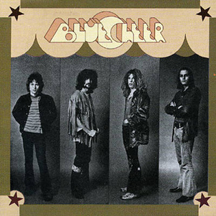BLUE CHEER
Blue Cheer was an American rock band that initially performed and recorded in the late 1960’s and early 1970’s and was sporadically active until 2009. Based in San Francisco, Blue Cheer played in a psychedelic blues-rock style, and are also credited as being some of the earliest pioneers of heavy metal, with their cover of “Summertime Blues” sometimes cited as the first in the genre. They have also been noted as influential in the development of genres as disparate as punk rock, stoner rock, doom metal, experimental rock, and grunge. “Blue Cheer” was the name of a variety of LSD made by chemist and Grateful Dead patron Owsley Stanley, and the band was probably named for that; although the name existed earlier, as the name of a laundry detergent for which the LSD variety itself was named. (More from Wikipedia)
I told the story of seeing Queens of the Stone Age with my wife Peggy in my last post; but their third album in 2002, Songs for the Deaf is probably when I realized that something was really going on out there in the larger world: rock music with a modern sound but with garage-rock roots. The Queens had a rotating line-up of like-minded musicians and grew out an earlier band with similar sensibilities called Kyuss; while they didn’t sell a lot of albums, they were a pioneer of the stoner-rock scene of the 1990’s. As the Allmusic article (by Eduardo Rivadavia) describes the band: “[T]he signature sound [of] Kyuss [combined] the doom heaviness of Black Sabbath, the feedback fuzz of Blue Cheer, and the space rock of Hawkwind, infused with psychedelic flashes, massive grooves, and a surprising sensibility for punk rock, metal, and thrash.” The connective tissue between the two bands is multi-instrumentalist Josh Homme, who also founded the popular Eagles of Death Metal.
(January 2013)
* * *
The band’s first album, Cactus was one of the best hard rock albums of 1970. The album opens with a fierce version of the Mose Allison song “Parchman Farm” (about the notorious Mississippi State Penitentiary of that name) – and not long after Blue Cheer recorded that classic blues song (misnamed “Parchment Farm”) on their debut 1968 album, Vincebus Eruptum – plus the Willie Dixon song “You Can’t Judge a Book by the Cover” that was made famous by Bo Diddley. But Cactus’s own songs rock just as hard, like “Let Me Swim”, “Oleo” and “Feel So Good”.
(April 2014)
* * *
Writing for Allmusic, Dean McFarlane says of the album: “From the opening cut, it is fairly apparent why the original album is so sought after – Magic Lantern is as fine a display of American psychedelia as late-’60s albums by It’s a Beautiful Day and Jefferson Airplane. This will appeal to fans of the fuzzed-out guitar antics of Cream and Blue Cheer.” There is also a long article in the “Biography” section in Allmusic (this time by Stanton Swihart) about Haymarket Square. The band name is taken from a place in Chicago where a famous labor riot took place in 1886.
(June 2015)
* * *
The opening track on Witchcraft Destroys Minds and Reaps Souls by Coven is called “Black Sabbath”. Coincidentally, or perhaps not coincidentally, the opening song on the debut album Black Sabbath by Black Sabbath is also called “Black Sabbath”. The Allmusic article on this album by Steve Huey, which came out the following year, opens with: “Black Sabbath’s debut album is the birth of heavy metal as we now know it. Compatriots like Blue Cheer, Led Zeppelin, and Deep Purple were already setting new standards for volume and heaviness in the realms of psychedelia, blues-rock, and prog rock. Yet of these metal pioneers, Sabbath are the only one whose sound today remains instantly recognizable as heavy metal, even after decades of evolution in the genre.”
(June 2016)















